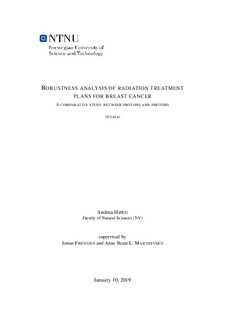| dc.contributor.advisor | Marthinsen, Anne Beate Langeland | |
| dc.contributor.author | Høeg, Andrea | |
| dc.date.accessioned | 2019-10-15T14:01:52Z | |
| dc.date.available | 2019-10-15T14:01:52Z | |
| dc.date.issued | 2019 | |
| dc.identifier.uri | http://hdl.handle.net/11250/2622372 | |
| dc.description.abstract | Protonterapi gir teoretisk sett en forbedret dosefordeling og dermed et mulig gunstigere behandlingsresultat for brystkreftpatienter enn fotonterapi. Teknikken har et stort potensiale for å spare risikoorganer, som for brystkreft pasienter er bl.a. hjertet og lungene. Utfordringen med protonstråling sammenlignet med fotonstråling er at dosefordelingen er mer sensitiv for endringer i pasientens anatomi gjennom behandlingsløpet. For å kompensere for dette kan protonplanene lages mer robuste under doseplanleggingen. Spørsmålet som undersøkes i denne avhandlingen er om de potensielle gevinstene av protonterapi blir ofret om protonplanene blir laget mer robuste. I denne masteroppgaven blir ulike aspekter av robusthet av strålebehandlingsplaner for brystkreft undersøkt, for både proton- og fotonplaner. Endringer i anatomi gjennom behandlingsforløpet kan bli visualisert ved å sammenligne planleggings CTen med cone-beam CT-bilder tatt ved ulike behandlingsfraksjoner. Slike cone-beam CTer kan bli brukt til å lage derformerte bilderegistreringer med planleggings CTen, for å evaluere den faktisk leverte dosen til pasient anatomien. For å undersøke sensitiviteten til doseplanen for isocenterendringer, ble det utviklet et script som inkrementelt endret setup-avvikene for strålefeltene i ulike retninger og rekalkulerte dosen, for å evaluere robustheten av planene. Verktøyene utviklet i denne oppgaven ble brukt i robusthetsanalyse av foton- og protondoseplaner for ti pasienter med høyresidig brystkreft. Denne retrospektive doseplanleggingsstudien viste at protonplanene var like robuste som fotonplanene for isocenterforflytninger opp til ± 4.5 mm. Den viste også at protonplaner var mindre robuste enn fotonplaner i den deformerte bilderegistrerings-analysen, i den forstand at dosen til målvolum og friske organer hadde en større relativ endring. Protonplanene viste likevel tilstrekkelig dekning av målvolumene og reduserte doser til risikoorganer, sammenlignet med fotonplanene. | |
| dc.description.abstract | Proton therapy does in theory propose improved dose distributions and thereby a possible more favorable treatment outcome for breast cancer patients than photon therapy. The technique has a great potential in sparing organs at risk, which for breast cancer patients are, among others, the heart and the lungs. The challenge with proton radiation compared to photon radiation is that the dose distribution is more sensitive to changes in patient anatomy during the treatment course. To compensate for this, the proton treatment plans may be made more robust during the treatment planning. The question investigated in this thesis is whether the potential benefit of proton therapy is sacrificed if the proton plans are made more robust. In this master thesis, various aspects of robustness of treatment plans for breast cancer radiation with both photons and protons have been studied. Changes in anatomy during the treatment session can be visualized by comparing the planning CT to cone-beam CTs taken at different treatment fractions. Such cone-beam CTs can be used to make deformed image registrations with the planning CT, to evaluate the actually delivered dose to the patient anatomy. This tool can also be used to evaluate the need for replanning during a treatment course. To investigate the sensitivity of isocenter deviations, a script has been made that incrementally changes the setup deviations of the treatment fields in different directions and recalculates the dose, to evaluate the plan robustness. The evaluation tools developed in this thesis have been used to compare the robustness of proton and photon plans for ten patients with right-sided breast cancer. This retrospective treatment planning project showed that the proton plans were as robust as the photon plans for isocenter perturbations up to ± 4.5 mm. It also showed that the proton plans were less robust than the photon plans in the deformed image registration analysis, in the sense that the target coverage and organ at risk sparing had a higher relative change. However, the protons plans still had adequate target coverage and reduced doses to the organs at risk, compared to the photon plans. | |
| dc.language | eng | |
| dc.publisher | NTNU | |
| dc.title | ROBUSTNESS ANALYSIS OF RADIATION TREATMENT PLANS FOR BREAST CANCER, A COMPARATIVE STUDY BETWEEN PROTONS AND PHOTONS | |
| dc.type | Master thesis | |
